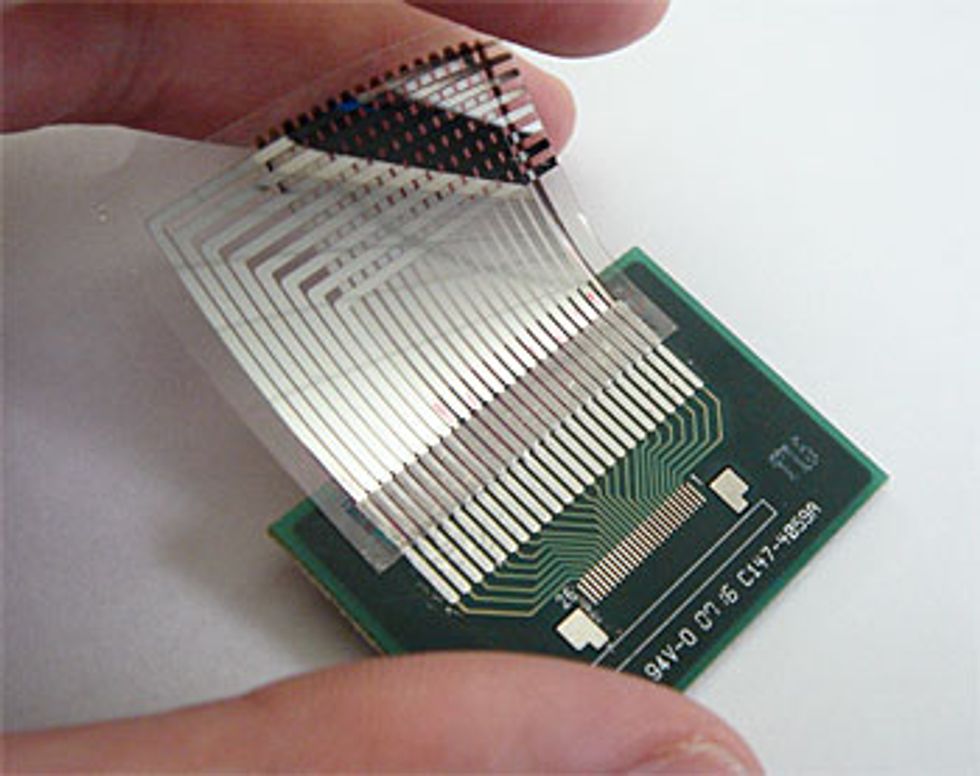10 December 2007—Taiwanese researchers say they have developed a simple, durable, and potentially inexpensive nonvolatile memory array made from a mix of plastic and gold nanoparticles. The array is a 16-byte device called an organic nonvolatile bistable memory. The researchers, from National Chung Hsing University (NCHU) and the quasi-governmental Industrial Technology Research Institute (ITRI), presented details of the device today in Washington, D.C., at the 2007 IEEE International Electron Devices Meeting. The Taiwanese team plans to integrate the memory into smart cards.
Engineers have been pursuing organic nonvolatile memories—devices made from plastic and other carbon-based chemicals—because they can potentially be manufactured cheaply using printing processes. But organic memory devices tend to break down in air and under the stress of many read-write cycles. According to Zingway Pei, one of the gold memory’s inventors and an assistant professor of electrical engineering at NCHU, recent measurements suggest that it endures more than 1000 switches and retains its data for roughly 10 days, even when exposed to air. Its stability may quickly improve, says Pei. ”Theoretically, the memory’s retention time can reach 30 days,” he says.
The new memory consists of gold nanoparticles mixed into a polymer called PCm, sandwiched between two aluminum electrodes. Reading the bit stored in the device involves applying a small voltage and measuring the resulting current. Ordinarily, the structure conducts little current, the state in which it is storing a 0. But push the voltage past 2 volts, and the current jumps 10 000-fold. Pei and his colleagues theorize that before that threshold, a trickle of electrons is hopping from gold nanoparticle to gold nanoparticle. But some get trapped along the way. At 2 volts, there are so many trapped electrons that they form a highly conductive path through the device. At that point, smaller voltages will continue to produce the high current, and the device is considered to be storing a 1. Erasing the bit is simply done by applying a strong negative voltage, sweeping away the trapped charges.
The voltages involved in writing bits can stress the plastic and make a device unstable by causing the nanoparticles to clump together. But the Taiwanese researchers found a way to prevent that by stabilizing the nanoparticles. ”In the memory device, gold nanoparticles are connected directly to polymer chains, which act as fingers that get entangled with the host polymer,” says Pei. ”Therefore, the stabilization of the structure of the organic memory can be ensured even if high-voltage stress is applied.”
Pei’s team plans to show off the device on 17 and 18 December at the 2007 International Symposium for Flexible Electronics and Display (ISFED), to be held in Hsinchu, Taiwan, and sponsored by ITRI.
An organic memory is considered essential to implement flexible electronics, such as radio-frequency identification (RFID), smart cards, e-paper, and flexible displays. In mid-March, ITRI launched Taiwan’s first laboratory dedicated to flexible electronics, with US $9.1 million in funding.
Other research groups are also pursuing organic nonvolatile memory devices using either different nanoparticles, such as carbon-60, embedded in the plastic or using the plastic as part of an organic transistor structure.
About the Author
Yu-Tzu Chiu reports on science and technology from Taipei.
